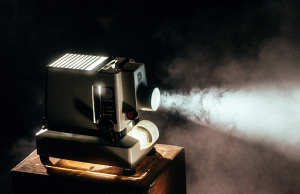
- Rare mental disorders are often depicted in horror movies in ways that are 1) inaccurate; and 2) exploitative.
- That being said, creative inspiration has to come from somewhere.
- Extraordinary mental health disorders like mass psychogenic illness and Capras syndrome might benefit from the Hollywood treatment.
- Just make sure you remember the distinction between fantasy and reality.
First, let’s clear up one thing: There’s nothing inherently spooky or dangerous about mental health conditions like dissociative identity disorder (split personality) and schizophrenia. But that hasn’t stopped filmmakers from exploiting these conditions again and again in their horror movies. Cinematic depictions of people with mental health disorders can range from benignly inaccurate to demonizing. So if you watch a horror movie this Halloween, understand that the “psychos” and “lunatics” that you might see portrayed are actually reflected nowhere in the DSM-5, which psychiatrists use to diagnose and treat mental health disorders.
People in real mental distress should not be exploited for their entertainment value. But if handled correctly, with maximum fantasy, the following rare mental disorders might have some scare potential on the big screen. You’re welcome, future filmmakers.
[Disclaimer: For the sake of Halloween, you may let your imaginations run wild here. But keep in mind that you are far more likely to be killed by a toppled vending machine than by someone with amputee identity disorder (see below).]

Mass Psychogenic Illness
Outbreaks of mass psychogenic illness (MPI), also called epidemic hysteria or mass hysteria, take place when multiple people “catch” physical symptoms that can’t be explained by medical science. Contagious behaviors like tremors or feelings of nausea can happen within peer groups, or even within broader communities via the social media vector.
These types of psychosomatic symptoms were once called hysterical illnesses or conversion disorders. They’re now known as functional neurological disorders (FNDs), characterized by symptoms that lack an organic, neurological origin, so scientists attribute them to psychological causes instead. And they can spread like wildfire. Here are some prime examples of MPIs through the years:
- Dancing plagues. In medieval Europe, hundreds of people at a time would sometimes fall victim to involuntary dancing epidemics or dancing manias, where folks would dance in a frenzied, trance-like state for days or weeks, sometimes until they died.
- June bug outbreak. In 1962, dozens of women at a textile factory in the United States began vomiting and itching (a common MPI symptom called pruritus). They thought that they were being bitten by insects concealed in a fabric shipment. But no insects were ever found.
- Miami mystery gas outbreak. In 1974, students and teachers at a Miami Beach elementary school began falling ill with symptoms of gas poisoning: headaches, dizziness, etc. Public health officials blamed anxiety hysteria.
- Schoolgirl tics in Leroy, NY. In 2011, multiple female students at a New York high school developed motor hysteria comprising facial tics and muscle twitching. They all recovered.
- Screaming in Malaysia. In 2019, a Malaysian girl named Siti (called the index case because she was the first one affected) was overcome by pain, dizziness, and “the face of pure evil” at school. Almost 40 other students were screaming and hyperventilating by the end of the day. MPI happens relatively frequently in Malaysia.
Culture-Bound Syndromes
A culture-bound syndrome is a health phenomena that’s commonly found in a specific society. Its existence may be informed by cultural beliefs endemic to a certain area. Here are some examples of culture-bound mental health conditions that might make good fodder for future Halloween movies (if treated with sensitivity, of course, and not the usual Hollywood xenophobia):
- Berserkergang. For centuries, aggressive Norsemen (usually called Vikings) were afflicted with specific physical symptoms before going into battle. Namely, they shivered, their teeth chattered, and they foamed at the mouth. Then these “berserkers” would begin fighting to the death in a trance-like rage.
- Bouffée délirante. In France, bouffée délirante (BD) is the mental health diagnosis for an acute, complex, short-term (lasting two to three weeks) psychosis. BD sufferers usually experience a rapid recovery.
- Piblokto. This mental health condition, which is also called pibloktoq or Arctic hysteria, occurs within indigenous populations who live near the Arctic Circle. The condition usually affects women in winter. Symptoms include running out into the snow (sometimes naked), screaming uncontrollably, and experiencing amnesia after the irrational behaviors.
- Koro syndrome. This syndrome usually occurs in Southeast Asia. It involves the distressing feeling that one’s penis is shrinking into one’s body. In English it’s called the genital retraction syndrome.
- Ghost sickness. In some Native American tribes, people can experience physical symptoms like weakness and a feeling of suffocation after being infiltrated by the energy of a deceased person.
Body Representation Disorders, Perceptual Disorders, and Delusions
Some of the most extraordinary mental health conditions involve perception, as when someone doesn’t feel their body to be their own body, or they suddenly perceive their husband of 20 years as someone else entirely. Here are a few of these extremely rare mental disorders, ripe for seasonal movie treatment:
- Zoanthro-prosopometamorphopsia. Prosopometamorphopsia is a rare condition where someone perceives human faces as highly distorted, usually as the result of a brain injury. In the “zoanthro” version of the disorder, other people might resemble dragons or fish.
- Alien hand syndrome. In this syndrome, someone’s hand may begin to levitate involuntarily, or the hand may slap the unaware person in the face. In some cases an affected hand will undo the work of an unaffected hand, like when the alien hand closes cupboard doors that a person has just opened.
- Apotemnophilia. This syndrome is also known as amputee identity disorder or body integrity identity disorder. It involves a preoccupation with amputating one’s own healthy limb, usually an arm or a leg. Apotemnophilia can also be directed toward other amputees in the form of sexual longing.
- Capgras syndrome. Capgras syndrome is a form of delusional misidentification. For example, a person with Capras might believe that their child is an impostor.
- Fregoli delusion. This delusion also entails misidentification. The person with Fregoli perceives different people as someone they know in disguise. They may also believe that their own mind inhabits another body, called subjective Fregoli syndrome. (Evil twin, anyone?)
- Ekbom syndrome. People with Ekbom syndrome suffer from delusional parasitosis, or the belief that their skin is infested with insects (ectoparasitosis). It can cause them to feel the sensation of bugs stinging or itching them. They may even try to remove the “bugs” with tweezers. Most doctors also consider Morgellons disease to be delusional parasitosis.
And Roll Film
Lest anyone believe that I’m belittling other peoples’ rare mental health conditions by suggesting their usage in horror movies, I’d also like to volunteer my own personal disorder to M. Night Shyamalan or whomever: exploding head syndrome. Yes, I diagnosed myself, but I almost certainly have it. Sometimes, when I’m sound asleep, I hallucinate a loud bang and a flashing light. Apparently this is nothing to worry about? Unless it’s cinematic foreshadowing for a zombie attack?! In any event, take care of your extraordinary brains and have a very happy Halloween!
*In the United States, the only recognized psychiatric diagnoses are catalogued in the DSM-5, and they must be diagnosed by a licensed mental health professional.













